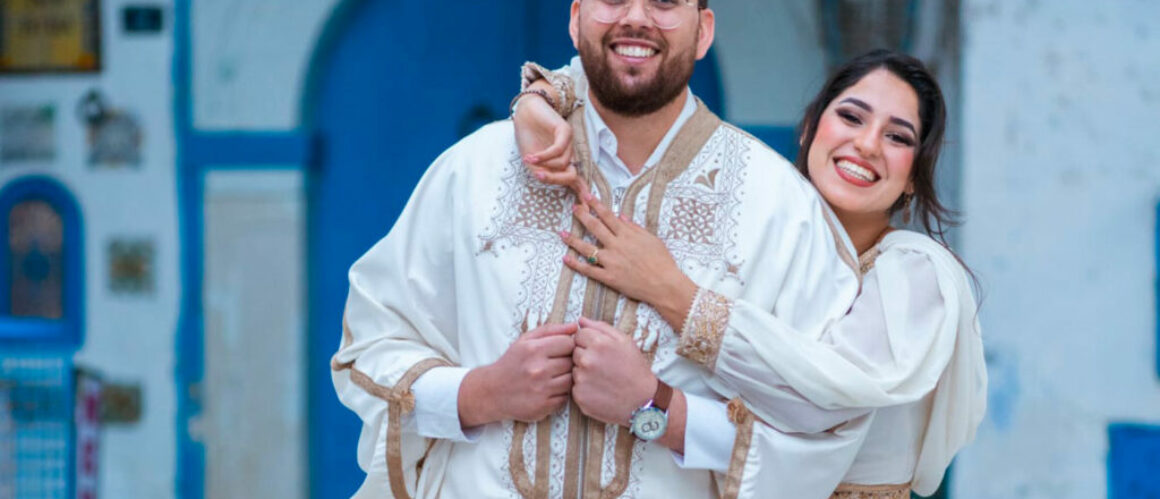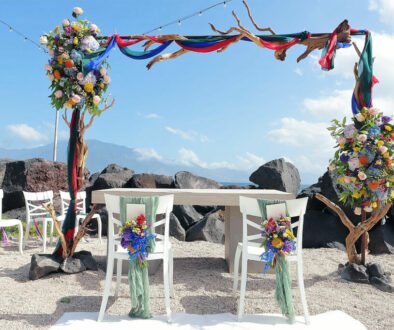Austria
The bride wears a headdress embellished with myrtle leaves. After the ceremony, the couple’s closest friends wear hats with robin feathers and entertain the guests with fun games and jokes. During the dance someone kidnaps the bride and her father will have to look for her. If he fails he will be subjected to penance. The midnight waltz that the bride and groom will dance outdoors is classic.
Australia
All communities living in Australia love parties very much, whether they live in the cities to give vent to the desire to celebrate and have fun, or whether they live in the open countryside. And marriage is one of the best occasions. After the ceremony, as the bride leaves the church, her guests hang satin horseshoes on her wrist ribbons to wish her good luck. The traditional cake is the Fruitcake, a fruit dessert that the bride and groom cut and offer together with the guests. At the reception, a guest is chosen who reads the telegrams of those who were unable to attend the wedding and who send their greetings in a very fun and colorful way. The dance with which the bride and groom begin the dance is the classic waltz. At the end of the reception, guests are invited to form a circle. The groom and bride will enter this circle to thank and greet all the guests who attended.
China
Since the beginning of the 90s, it has become fashionable to get married in European dress and, thanks to well-being, the forms of marriage are numerous and the expenses are surprising. The bride’s color is red, because white is the color of funerals and death. Traditionally, men are advised to get married at 28 and women at 25. Fasting and silence of the bride on the wedding day, the exchange of geese as a symbol of long life and the use of umbrellas during the wedding procession are obligatory.
Egypt
Ancient Egypt was the first civilization to declare marriage a relationship recognized by law. Most weddings take place in hotels. The newlyweds arrive at the ceremony room in a car decorated with ribbons and flowers and are welcomed by the Zaffa, a group of belly dancers and percussionists who surround them and sing to celebrate the event. Once in the room the newlyweds take their places on two thrones, before the arrival of the guests. Then the ceremony will begin, the most important moment of which is the exchange of rings from the right to the left index finger. The dances are opened by the spouses and include traditional Egyptian music and dancers. After cutting the wedding cake, the new bride throws the bouquet (here too it is thought that the one who manages to catch her bouquet will be the next to get married). The buffet will then be declared open, full of delicious dishes.
France
As in Italy, French law only recognizes civil marriage contracted in the municipality. Marriage in Church is a free choice of spouses based on their religious beliefs. The requirements for contracting marriage are rigorous: the future spouses must, in fact, present a medical certificate of healthy and robust constitution and blood tests to prevent the transmission and spread of diseases. Even if the religious ceremony is not celebrated, the bride’s dress will always be long and the groom will wear a double-breasted suit. Tradition and modernity are the characteristics of the reception: alongside the lavish lunches typical of this event, it is not difficult, in fact, to find couples having lunch with a crepe in the bar near the town hall where they got married.
Japan
A very particular type of arranged marriage is widespread in Japan: around the age of 25 the girl prepares her own personal file with studies, work aspirations, preferences and hobbies and forwards it among work colleagues, relatives and friends. In this way she can be contacted by guys looking for a wife and interested in her requirements. The two young people thus begin to meet to verify their affinities and only later decide whether to get married or not. The Japanese believe that this way they can create stronger couples. The Shinto wedding ritual is very suggestive: the spouses, wearing two particularly sumptuous kimonos, each drink three times from a bowl containing rice and sake. However, the fascination with Western culture is very strong. In recent years a real trend has arisen among Japanese married couples which is to come to Italy and redo their wedding according to European customs.
India
Indian culture bases the entire society on a rigid division into castes. Hence the common practice of arranging marriages when children are still small. The day chosen for the ritual must fall at an astrologically favorable time. The celebrations begin seven days before the wedding and continue for a long time. The Hindu ritual requires the bride to wear a red silk sari. The man, however, dresses in white and all the guests wear rich colored silk robes. In the chosen room, the family arranges a sort of temple, with a canopy decorated with beautiful flowers. On the appointed day the bride arrives first, but she hides, then the groom arrives and as she passes, lit torches are waved and grains of rice are thrown. At this point they both position themselves under the canopy and a very long and complex, but suggestive ceremony begins: in the temple, a whole series of deeply symbolic gestures takes place. The culminating moment of the ritual is when four turns around the fire are made to obtain divine blessing.
England
England is the country that, towards the end of the 19th century, introduced the custom of cutting the wedding cake during the reception. The bride arrives at the church along a path covered in flowers. If the groom is a soldier, the couple exits the church passing under an arch made of swords (as in Italy). If the wedding is civil, the spouses will pass under an arch made up of objects that have a precise reference to the life of the couple (e.g. if they are golfers the arch will be made up of golf clubs). After the ceremony the bride embroiders a cross on her husband’s dress as a sign of her love for her. A superstitious bride will throw a plate of cake out the window: the more pieces it breaks into, the happier the couple’s life will be. If the plate doesn’t break the marriage is doomed to fail.
Fiji Islands
The wedding, traditionally, is held just before sunset by the sea. And this rule, with all the other local customs, is also kept alive for tourists who want to get married in Fiji in a civil ceremony. The “canopy” is created with fresh palm branches and leaves woven together. Palm fiber carpets are spread on the ground above which a throne is placed, which has an old tapa fabric as its roof (obtained from the processing of beaten mulberry leaves). Fabrics with typical Melanesian abstract decorative designs are then added around the throne. All the inhabitants of the neighboring villages participate in the ceremony, dressed up and singing for the bride and groom. At this point a Fijano in jacket, tie and kilt begins the ceremony. At the end, among the songs that follow one another, the spouses get on a boat and move away towards the horizon, as dictated by the propitiatory tradition of Fijian weddings.
Kenya
When a man, after observing a woman for a long time, decides to declare himself, he offers her snuff. If she accepts she will be invited to work in the future groom’s mother’s field. Later the girl will in turn invite the man and her parents to her house for the full approval of both families. During lunch, the father of the future bride will drink the beer offered to him; if, however, at the last moment the girl decides not to marry again, he will pour the beer on the ground. The house of the future spouses is built traditionally with the help of the entire community and will be made of mud, with a thatched roof and without windows. The girl does not know the date of her wedding: on the same evening of the ceremony, her future husband, with the help of some of her friends, will kidnap her from her parents’ house. Only after a few days will the bride be able to return to her native home to collect personal items that she had not had time to bring with her on the evening of the wedding.
Mexico
Before the wedding, wreaths of flowers, pots and pans made of clay are hung above the door of the future groom. During the ceremony, the parents of the bride and groom or even a happily married couple place a large necklace made of pearls and a crucifix (symbolizing the rosary) on the bride and groom to represent the union and to remind the new couple that they will never have to break up with. The ceremony cannot be considered concluded until the groom gives the bride thirteen (this number represents Jesus) gold coins as evidence of her commitment to taking care of her.
Holland
A young Dutch girl believes she will get married within the year if the first person she sees on her eighteenth birthday is a man. Instead of a ring, the young man from Holland gives the future bride a pair of wooden shoes. The bride keeps them and will wear them on the wedding day. Before the wedding, a Dutch tradition requires friends of the future spouses to walk in pairs and sing neighborhood songs. At the end of each song a different couple will start another one which they will all sing together. In the four weeks before the wedding, the girl will go to church wearing a red wedding dress to let the bachelors know that she is close to the wedding. On the wedding day she will instead wear a black dress to mourn the loss of her youth.
Zambia
If you happen to be in the villages during a wedding it is likely that you will be invited: it’s good luck! The woman in Zambia has a real economic-commercial value. In most families, women take care of family life and raise siblings and their loss means a tremendous loss of value in terms of resources, work and potential money for the family. This is why parents set a price to give their daughter in marriage. And this price is set in money and other goods such as livestock or clothing. Cases in which the future groom is forced to go into debt to pay for this “gift” are not uncommon. If the groom is however not liked by the bride’s father, he will set a very high price to avoid the marriage.




